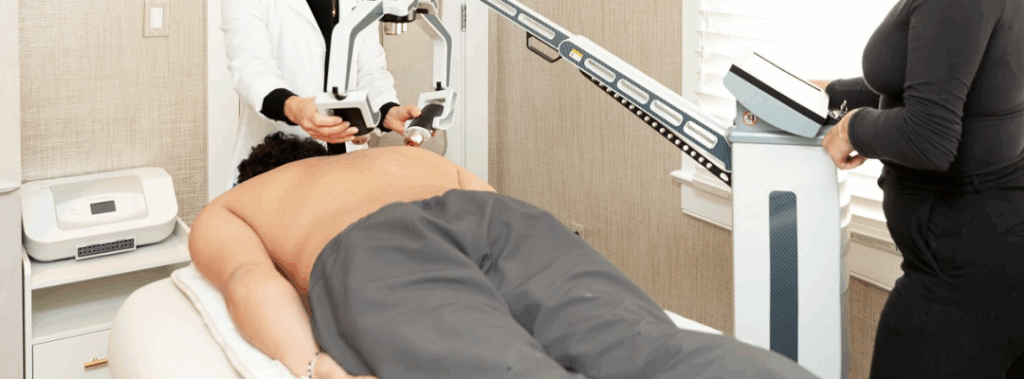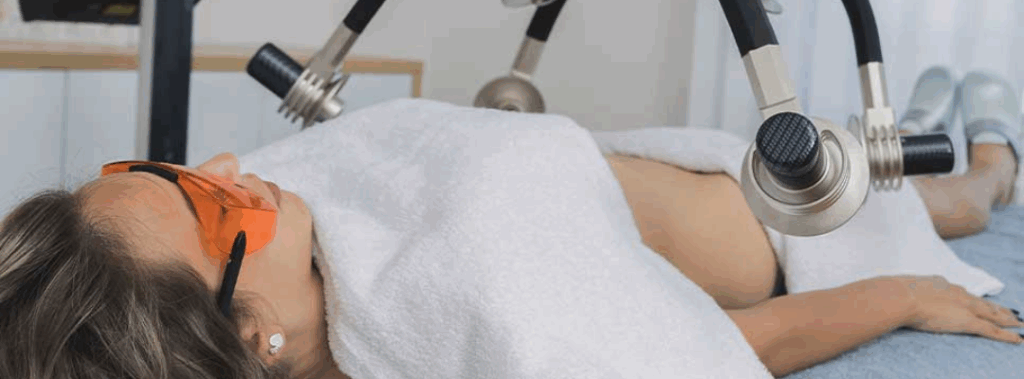
Millions of Americans suffer from muscle and joint pain. According to a study published in March 2020, health care spending increased from an estimated $1.4 trillion in 1996 to $3.1 trillion in 2016. Among the conditions included in the study, back and neck pain had the highest amount of health care spending, followed by other musculoskeletal disorders. In other words, the need for pain-relieving treatment has been on the rise for quite some time.
One way to help patients find relief from inflammation and pain is to use laser therapy. The American College of Physicians strongly recommends that clinicians use non-pharmacological treatments such as laser therapy to treat conditions like chronic low back pain. Laser therapy can positively affect musculoskeletal pain and help patients feel better and heal faster. By using laser therapy, physicians can treat patients effectively and avoid prescribing opioids or surgery for pain.
Doctors can offer laser treatment by applying cold or hot lasers. The main difference between cold and hot lasers is maximum power output. However, greater power also increases the risk of injury. It’s worth weighing the pros and cons of hot and cold lasers, so you can choose a device you’re comfortable using and that will offer the most significant benefits to your patients.
In this post, we’ll explore what laser therapy is and how hot lasers differ from cold ones. If you need assistance selecting a cold laser for your practice, we’ll be happy to assist you at Erchonia.
How Does Laser Therapy Work?
First, to understand how laser therapy works, it’s essential to know what lasers are. Lasers are beams of light that travel at specific frequencies. Light is composed of photons, which are particles consisting of electromagnetic radiation. During laser therapy, a physician places a handheld laser device to the patient’s skin or directly above the affected area. The photons penetrate the skin and underlying tissues, triggering cellular activity and resulting in pain relief, muscle relaxation, decreased inflammation and tissue regeneration. Using lasers to treat pain is called photobiomodulation.
What Does Laser Therapy Treat?
Physicians can use laser therapy can treat a vast range of musculoskeletal conditions, such as:
- Carpal tunnel syndrome
- Arthritis
- Osteoarthritis
- Rheumatoid arthritis
- Tendonitis
- Fibromyalgia
- Temporomandibular joint dysfunction
- Tennis elbow
- Plantar fasciitis
- Sciatica
- Headaches
- Herniated disc
- Muscle spasms
- Sprains and strains
Laser therapy is also used in veterinary care to treat arthritis and soft-tissue injuries and promote healing after surgery.
Benefits of Laser Therapy
Laser therapy is beneficial in treating musculoskeletal conditions for the following reasons:
- Fast: Laser therapy only takes a few minutes. Although patients may need to attend several sessions before their treatment is complete, they should be able to fit laser therapy easily into their schedules. They also won’t need to set aside time to recover, and they can return to work immediately after each appointment. Also, studies have shown long-lasting results.
- Painless: Laser therapy is a painless, non-invasive procedure. It’s easy to apply and can be performed in your office instead of an external facility.
- Non-pharmacological: Physicians can use laser therapy to help patients manage pain without prescribing addictive opioids. Since opioids have a high risk of misuse, laser therapy makes a safer alternative to pain relief.
- Safe: Unlike surgery or pain medications, cold laser therapy does not have any side effects. With laser therapy, patients don’t have to worry about any complications associated with surgery or endure long recovery times.
- Effective: Over 4,000 studies show the positive effects of cold laser therapy, and it’s cleared by the U.S. Food and Drug Administration (FDA) to treat various conditions.
Find a Provider Near You
What Are Hot Lasers and Why Are They Used?
Hot lasers are known as Class IV lasers. Class IV lasers have a power output above 500 milliwatts (mW). At a lower power range, hot lasers are used for therapeutic purposes. Higher-intensity Class IV lasers can cut tissue during surgical procedures. Class IV lasers are called hot lasers because they can rapidly increase tissue temperatures.
Doctors might prefer hot laser therapy, also called high-intensity laser therapy (HILT), to quickly provide topical heating for tissue and muscle relaxation. This allows physicians to help patients feel temporary relief. Depending on a patient’s needs and condition, they may start feeling better only after a couple of HILT sessions. However, patients with severe injuries or chronic pain may need additional treatments.
What Are Cold Lasers and Why Are They Used?
Cold lasers are also known as low-level lasers, and they are among Class II and Class III lasers. Cold lasers have a power output of less than 500 mW. These lasers are called “cold” because they do not generate a thermal effect.
Using cold lasers for therapy is often referred to as low-level laser therapy (LLLT). While cold lasers use less power than Class IV lasers, they have a broader range of FDA market clarences. Physicians apply cold laser to the treatment areas for several minutes, normally ranging from 5-20 minute sessions. They can treat multiple points in a single session, which makes this method especially efficient for patients seeking treatment.
LLLT is nothing new. According to an article published in the MedCrave Online Journal of Orthopedics and Rheumatology, LLLT has been shown to reduce inflammation, swelling and pain, and promote healing in musculoskeletal conditions for over 40 years.
Recent studies continue to support the benefits of LLLT. For example, a meta-analysis from 2019 examined published randomized controlled trials to evaluate the effects of LLLT on fibromyalgia. The researchers concluded that LLLT is a safe and effective treatment for fibromyalgia.
Another meta-analysis from 2019 reviewed randomized controlled trials to determine if LLLT is an effective treatment for plantar fasciitis. According to the study’s researchers, LLLT significantly reduces heel pain, and its results last for three months after treatment.
A 2019 study published in the Journal of Pain and Relief explored the use of the Erchonia FX 635 Class II laser on low back pain. The study found patients continued to experience decreased pain 12 months after treatment. The researchers concluded that LLLT effectively treats low back pain and is a safer alternative to nonsteroidal anti-inflammatory medications and opioids.
Chiropractors, physical therapists, orthopedic surgeons and other health care providers might choose LLLT to safely treat their patients’ pain or inflammation without the risks associated with more powerful lasers.
Veterinarians may also use LLLT to treat dogs with chronic pain and conditions like osteoarthritis. According to a study published in March 2020, preliminary findings suggest that LLLT improves the quality of life for dogs with osteoarthritis and increases client satisfaction.
Which Therapy Is Better?
Class IV lasers are categorized by the FDA under product code “ILY”. This category started as a heating pad and has expanded to thermal lasers, which are intended to “provide topical heating for the purpose of elevating tissue temperature for temporary relief of muscle and joint pain and stiffness, arthritis pain, or muscle spasm, the temporary increase in local blood circulation and/or promoting relaxation of the muscle”.
LLLT is a non-thermal process and classified under FDA product code NHN, powered light-based laser non-thermal instrument with non-heating effect for adjunctive use in pain therapy. Blinded and controlled trials are required for new 510(k) indications. LLLT is FDA cleared for Neck & Shoulder, Carpal Tunnel, Plantar Fasttiss, knee, low back, and overall nociceptive musculoskeletal pain.
An article published by Harvard Medical School titled “Biphasic Dose Response in Low-Level Light Therapy” concludes LLLT delivered at low doses tends to work better than the same wavelength delivered at high levels, which illustrates the basic concept of biphasic dose response or hormesis.
How to Choose a Laser for Your Practice
If you’re considering investing in a therapeutic laser, there are plenty of factors to consider other than whether a laser is hot or cold. With so many options on the market, it can be challenging to select a laser device that meets your needs. To help you through the process, here are some factors to consider and questions to ask yourself:
- The device manufacturer: Before you purchase a laser from a manufacturer, research the company and consider how long it’s been in business and where it’s located. Find out if their equipment incorporates the latest research. A reputable company offers support and is committed to innovation and safety for both physicians and patients.
- The equipment: Look at the laser equipment and assess its durability. Consider if the device is easy to use and if your employees will be able to deliver treatments effectively with it.
- Return on investment: Consider the device’s cost and the number of patients you plan to treat each month with the laser. In general, Class IV lasers are more expensive than cold ones.
- FDA Market Clearance: Look at the FDA market clearance for indications of use.
- Research: Look at the level of research performed. Case studies are considered the lowest form of research, while level 1 double-blind placebo-controlled studies are the highest.
Contact Erchonia for More Information
If you’re a health care provider searching for a safe and effective way to help your patients recover from musculoskeletal injuries and pain, laser therapy is an excellent alternative to medications and surgery. Cold laser therapy allows you to treat patients effectively without the risks associated with high-intensity lasers.
At Erchonia, we can help you select a cold laser device to meet your needs. As a developer and manufacturer of low-level lasers, we are committed to advancing LLLT through clinical and scientific research. We are continually innovating to ensure we offer the high-quality technology clinicians and patients expect.
We offer several types of laser devices designed to relieve pain and treat various musculoskeletal conditions. For example, our XLR8 handheld laser uses LLLT to stimulate adenosine triphosphate (ATP) production and reduce oxidative stress. Health care providers can use the XLR8 to treat chronic pain, providing a safe alternative to pain medications. The cordless handheld design also makes transporting the device between rooms easier, which reduces setup time and increases productivity.
Our FX 635 laser is the world’s first laser designed to treat chronic low back pain. Using low-level laser technology, the FX 635 reduces inflammation and promotes recovery allowing your patients to finally find relief from back pain. It can offer targeted and precise relief due to its laser diode arms, and it can work well alongside other treatments like muscle massages.
If you’re ready to find a dependable product from the leader of LLLT technology, let us know. Contact us today for information about our low-level lasers, or check out our clinical research to learn more.






